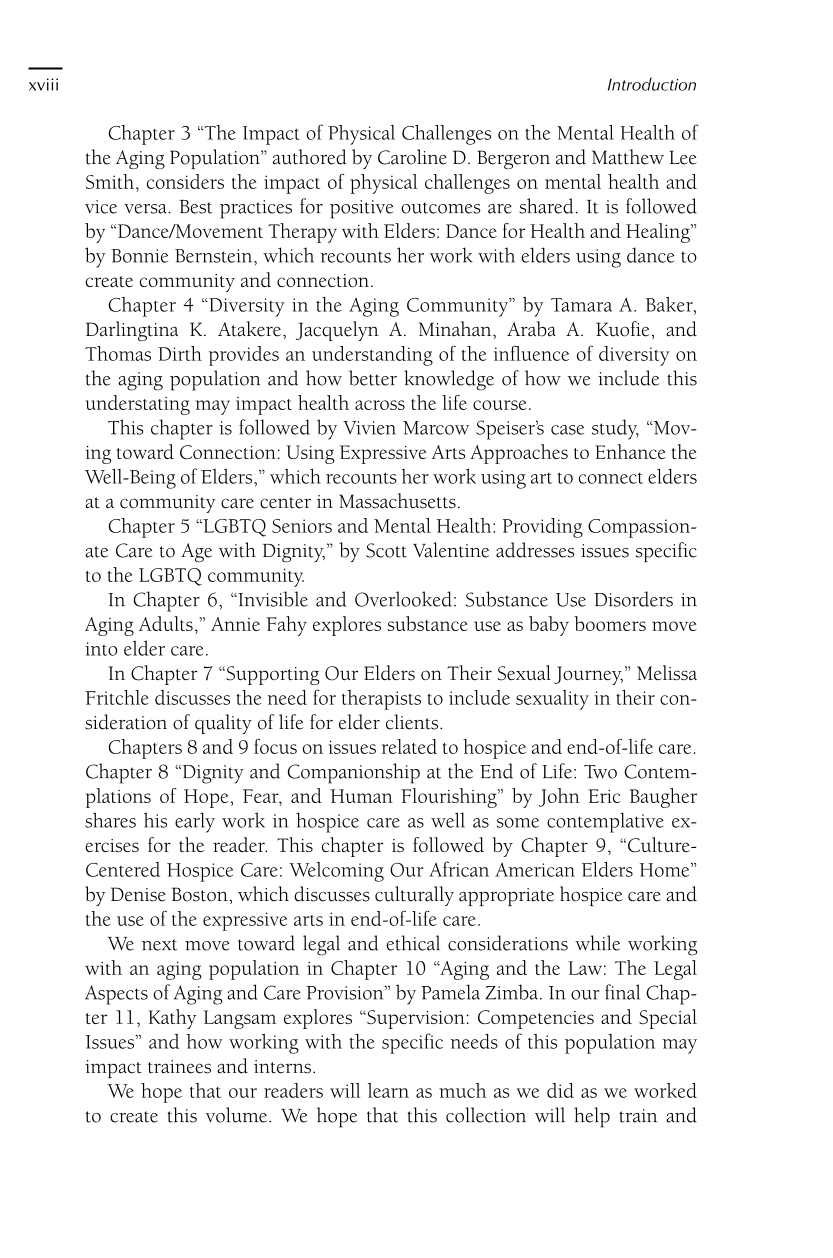xviii Introduction
Chapter 3 “The Impact of Physical Challenges on the Mental Health of
the Aging Population” authored by Caroline D. Bergeron and Matthew Lee
Smith, considers the impact of physical challenges on mental health and
vice versa. Best practices for positive outcomes are shared. It is followed
by “Dance/Movement Therapy with Elders: Dance for Health and Healing”
by Bonnie Bernstein, which recounts her work with elders using dance to
create community and connection.
Chapter 4 “Diversity in the Aging Community” by Tamara A. Baker,
Darlingtina K. Atakere, Jacquelyn A. Minahan, Araba A. Kuofie, and
Thomas Dirth provides an understanding of the influence of diversity on
the aging population and how better knowledge of how we include this
understating may impact health across the life course.
This chapter is followed by Vivien Marcow Speiser’s case study, “Mov-
ing toward Connection: Using Expressive Arts Approaches to Enhance the
Well-Being of Elders,” which recounts her work using art to connect elders
at a community care center in Massachusetts.
Chapter 5 “LGBTQ Seniors and Mental Health: Providing Compassion-
ate Care to Age with Dignity,” by Scott Valentine addresses issues specific
to the LGBTQ community.
In Chapter 6, “Invisible and Overlooked: Substance Use Disorders in
Aging Adults,” Annie Fahy explores substance use as baby boomers move
into elder care.
In Chapter 7 “Supporting Our Elders on Their Sexual Journey,” Melissa
Fritchle discusses the need for therapists to include sexuality in their con-
sideration of quality of life for elder clients.
Chapters 8 and 9 focus on issues related to hospice and end-of-life care.
Chapter 8 “Dignity and Companionship at the End of Life: Two Contem-
plations of Hope, Fear, and Human Flourishing” by John Eric Baugher
shares his early work in hospice care as well as some contemplative ex-
ercises for the reader. This chapter is followed by Chapter 9, “Culture-
Centered Hospice Care: Welcoming Our African American Elders Home”
by Denise Boston, which discusses culturally appropriate hospice care and
the use of the expressive arts in end-of-life care.
We next move toward legal and ethical considerations while working
with an aging population in Chapter 10 “Aging and the Law: The Legal
Aspects of Aging and Care Provision” by Pamela Zimba. In our final Chap-
ter 11, Kathy Langsam explores “Supervision: Competencies and Special
Issues” and how working with the specific needs of this population may
impact trainees and interns.
We hope that our readers will learn as much as we did as we worked
to create this volume. We hope that this collection will help train and









































































































































































































































































































